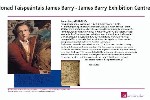James Barry Exhibition Centre
James Barry (1741-1806)
Born in Cork; trained as an artist under John Butts before moving to Dublin. His first major painting, The Baptism of the King of Cashel by St. Patrick, attracted a prize in 1763 from the Dublin Society and also the patronage of Edmund Burke. Burke arranged for him to move to London the following year to work under James “Athenian” Stuart. In 1765, again under Burke’s patronage, he embarked on a lengthy tour of Europe. Having studied the works of Poussin and Le Sueur in Paris, he moved to Rome, where he continued to developed a lifelong passion for classical antiquity and history painting. He also studied in Bologna, receiving a diploma from the Accademia Clementina.
Fired with enthusiasm, he returned to London in 1771 and produced a number of history paintings that quickly won him membership of the Royal Academy. Supported by the sales of prints, he embarked on his most important work, a cycle of six complex allegonical paintings, in the Royal Academy in 1782 but was expelled in 1799 for radical political views and his increasingly erratic attacks on other academics. His later years were marred by paranoia and a severe persecution complex.
He died in poverty but is now regarded as the most important neo-classical painter in the eighteenth-century.
- Peter Murray
James Barry (1741 – 1806) Péintéir
Rugadh i gCorcaigh é. Caitliceach ab ea a mháthair agus Protastúnach a athair; bhí sé faoi oiliúint ag an ealaíontóir John Butts sarar bhog sé go Baile Átha Cliath. Bhronn Cumann Bhaile Átha Cliath duais air i 1763 as a chéad phictiúr mór The Baptism of the King of Cashel by St. Patrick agus mheall pátrúnacht Edmund Burke, an mór-fhealsamh a tháinig ó Chorcaigh. Rinne Burke socruithe do Barry dul go Londain an bhliain dár gcionn chun dul i mbun oibre faoi stiúir James ‘Athenian’ Stuart. I 1765, arís faoi phatrúnacht Burke, chuaigh sé ar thuras fada timpeall na hEorpa. I ndiaidh dó staidéar a dhéanamh ar an méid a bhí déanta ag Poussin agus Le Sueur i bPáras, bhog James Barry chun na Róimhe, áit inar tháinig bláthú ar mhian a shaoil, na seaniarsmaí clasaiceacha agus péinteáil staire. Rinne sé staidéar i Bologna, áit ar bhain sé dioplóma amach ón Accademia Clemetina.
D’fhill sé ar Londain i 1771 lán de dhíogras agus chruthaigh sé roinnt pictiúr staire a thuill ballraíocht dó sa Royal Academy gan mórán moille. Tá Portraits of Burke and Barry in the Characters of Ulysess and A Companion fleeing from the Cave of Polyphemus (1776) ar cheann de na seoda is luachmhaire i nDánlann Crawford i gCorcaigh. Mhair sé ar dhíolacháin phriontaí nuair a thug sé faoin obair is tabhachtaí a bhí aige go dtí sin; sraith de sé phictiúr casta fáthchiallacha, sa Royal Society of Arts i 1782.
Díbríodh ón Royal Academy é i 1799 mar gheall ar a thuairimí radacacha polaitíochta agus toisc ionsaithe taomacha a dhéanamh ar lucht léinn eile, ar nós an Ridire Joshua Reynolds, bunaitheoir an acadaimh. Cheap sé gur lú an spéis a bhí ag an lucht léinn in ionracas ealaíne ná sláine airgeadais. Níor phós Barry riamh agus cuireadh blianta deiridh a shaoil amú de dheasca coimpléacs géarleanúna.
Fuair sé bás sa bhochtaineacht. Tá cáil Barry imithe ó neart go neart agus é aitheanta mar an péintéir nuachlasaiceach is tábhachtaí a mhair sa Bhreatain san ochtú haois déag.
- Peter Murray


